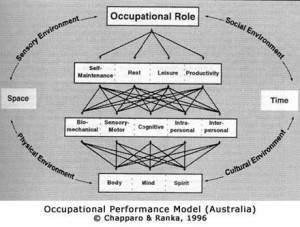STAGE FIVE (1994-1996):
Purpose:
The purpose of Stage Five 1) to continue field testing the established constructs in practice specific settings, 2) to consolidate theoretical support for the constructs, and 3) to encourage others to write about the application of the model to various aspects of practice.
Methods:
To fulfil the purpose of Stage 5, ongoing informal dissemination of the model occurred through presentations to staff of occupational therapy departments (Ranka, 1995), and special interest groups (Chapparo, & Ranka, 1995; Ranka, & Chapparo, 1995), and presentations at international conferences (Chapparo, 1996; Ranka, 1995). Feedback obtained from these activities was considered relative to various aspects of the model. Occupational therapists were invited to submit manuscripts that explained how they were applying the model in various practice domains.
Outcome:
| 1. | There was confirmation that the existing structure could explain occupational therapy practice in diverse cultures and practice domains. |
| 2. | A monograph was prepared for formal dissemination and scrutiny by members of the profession. |
SUMMARY:
This article has outlined the process of model building that has resulted in a model of Occupational Performance. The stimulus for model development came from the perceived need for a conceptual model of occupational therapy practice and human occupations that was able to organise occupational therapy content within the undergraduate curriculum at The University of Sydney. The current model incorporates eight major constructs that include: occupational performance, Occupational role, occupational areas, occupational performance components, core elements of occupational performance, environment, space and time. These constructs emerged through a circular process of theorising that included literature review, field-testing, reflection and model construction. This circular process is ongoing and the current form of the model is viewed as one stage in the evolution of future conceptual notions of occupational performance.
Figure 4: Current model of Occupational Performance

